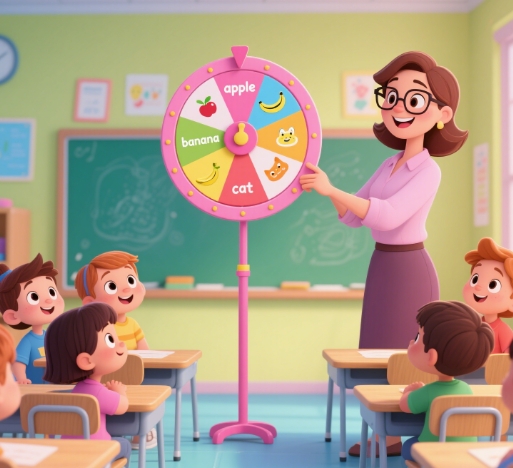In an era where digital innovation continually reshapes learning landscapes, educators and learners alike are seeking dynamic, engaging tools to elevate educational outcomes. Enter wheel games—a versatile, interactive medium that transcends traditional teaching methods, offering a blend of excitement and structured learning. Far beyond mere entertainment, wheel games for educational purposes have emerged as a powerful pedagogical tool, fostering active participation, enhancing knowledge retention, and catering to diverse learning styles. This article explores how these games can revolutionize education, their multifaceted benefits, and practical strategies for integrating them into various learning environments.

The Cognitive Edge: Why Wheel Games Resonate in Education
At their core, wheel games tap into fundamental cognitive principles that drive effective learning. The element of chance inherent in spinning a wheel activates the brain’s reward center, creating a sense of anticipation and motivation. This emotional engagement significantly boosts information processing, as learners become more invested in the outcome of each spin. Unlike passive learning modalities, where information is delivered in a one-size-fits-all manner, wheel games encourage active mental participation. Whether reviewing vocabulary, solving mathematical problems, or exploring historical timelines, the act of interacting with the wheel transforms memorization into an immersive experience.
Moreover, wheel games address a critical challenge in modern education: combating learner apathy. Studies show that students retain up to 70% more information when they are actively involved in the learning process. The visual and kinesthetic aspects of wheel games—watching the wheel rotate, anticipating the stop, and reacting to the result—create a multisensory experience that caters to different intelligences. Visual learners benefit from the colorful displays and clear categorization of content, while kinesthetic learners thrive on the tactile interaction. This inclusivity makes wheel games an ideal tool for diverse classrooms, where students have varying strengths and preferences.
Versatility in Application: Tailoring Wheel Games to Diverse Learning Goals
One of the most compelling features of educational wheel games is their adaptability across subjects and age groups. In language learning, teachers can design wheels with grammar rules, vocabulary words, or sentence structures, turning tedious drills into engaging challenges. For example, a wheel divided into sections labeled “past tense verbs,” “adjectives,” and “prepositions” can prompt students to create coherent sentences, fostering both creativity and linguistic accuracy. In mathematics, wheels might contain arithmetic problems, geometric concepts, or statistical scenarios, allowing learners to practice problem-solving in a low-pressure, game-like setting.
Higher education and professional training also stand to gain from wheel games. In business courses, wheels can simulate decision-making scenarios, with each segment representing different market conditions, consumer behaviors, or strategic options. This hands-on approach helps students develop critical thinking and adaptability, skills essential in today’s volatile professional landscape. Even in soft skills training, such as public speaking or conflict resolution, wheels can generate topics or role-play scenarios, helping learners build confidence and practical expertise.
Designing Effective Educational Wheel Games: Key Considerations
To maximize the educational value of wheel games, careful design is essential. First, clarity of purpose: each game should align with specific learning objectives, whether reinforcing factual knowledge, developing procedural skills, or promoting collaborative learning. The content must be well-organized, with categories that are distinct yet interconnected, allowing for meaningful interactions. Visual design also plays a crucial role—using vibrant colors, legible fonts, and intuitive icons can enhance user engagement and comprehension.
Technology further amplifies the potential of wheel games. Digital platforms like Spin the Wheel offer customizable templates, enabling educators to create tailored games in minutes. These tools often include features such as sound effects, animated spins, and progress tracking, which enhance the gaming experience while providing valuable data on learner performance. Teachers can analyze which sections students engage with most, identify knowledge gaps, and adjust their instruction accordingly. This data-driven approach ensures that wheel games are not just fun activities but strategic components of a holistic learning plan.
Overcoming Challenges: Ensuring Balance and Purpose
While the benefits of wheel games for educational purposes are evident, it is essential to use them strategically. Over-reliance on games can dilute their impact, so integrating them as part of a broader curriculum is key. Educators should balance game-based activities with traditional instruction, reflection sessions, and real-world applications to ensure comprehensive learning. Additionally, aligning game difficulty with learners’ skill levels is crucial—too easy, and they become boring; too hard, and they cause frustration. Gradual scaffolding, where games start simple and increase in complexity, helps maintain optimal engagement and learning efficiency.
Another consideration is assessment. While wheel games are excellent for formative assessment—providing immediate feedback during gameplay—they should be complemented by other evaluation methods to measure long-term retention and deeper understanding. Combining game-based metrics with quizzes, projects, and peer reviews creates a well-rounded picture of student progress.
The Future of Learning: Embracing Interactive Innovation
As education continues to evolve, the role of interactive tools like wheel games will only grow more significant. They embody the shift toward learner-centered education, where engagement and enjoyment are not just byproducts but essential components of the learning journey. By leveraging the power of play, educational wheel games make knowledge acquisition an adventure, transforming classrooms into dynamic hubs of exploration and discovery.
In conclusion, wheel games are more than just a novel teaching tool; they are a gateway to transformative learning experiences. Whether used in elementary classrooms, university lectures, or corporate training, their ability to engage, motivate, and educate is unparalleled. As educators and developers continue to unlock their potential, the future of education looks not just informative, but truly immersive—one spin at a time.
For innovative, customizable wheel games that bring education to life, look no further than Spin the Wheel. Designed to inspire curiosity and foster growth, our tools are transforming learning environments worldwide. Discover how we can help you create engaging, effective educational experiences—visit us today and start spinning toward smarter learning.